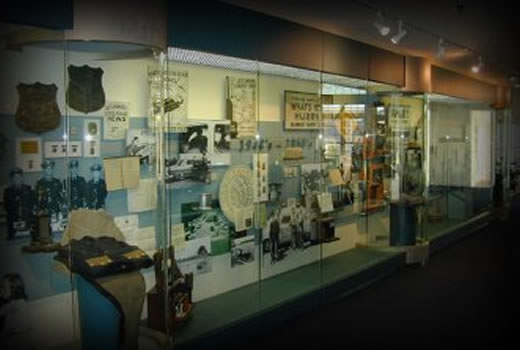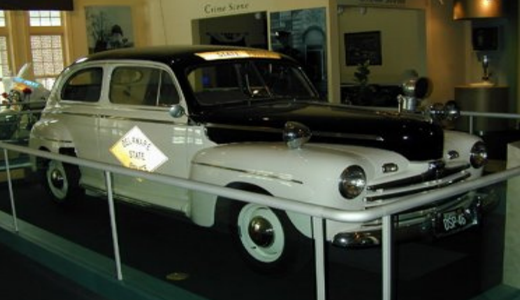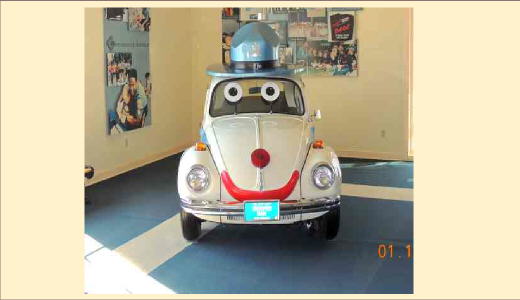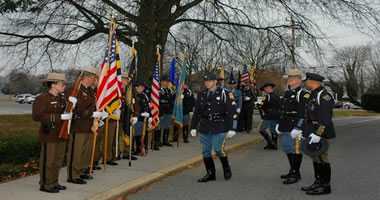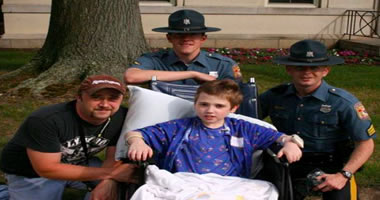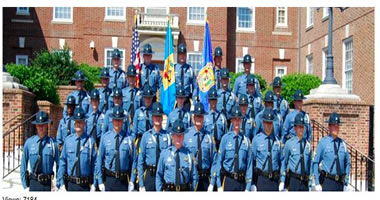History of the Delaware State Police - 1995-1999
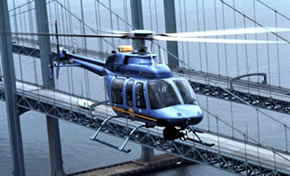 The Delaware State Police Aviation Section moved its north unit into a new hanger at the Summit Airport in February of 1997, in Middletown. They had previously been located at the Wilmington Airport, which had been the site of the unit for fourteen years. The new hanger is touted as a state of the art facility, with enough space to house most of the divisional aircraft under one roof.
The Delaware State Police Aviation Section moved its north unit into a new hanger at the Summit Airport in February of 1997, in Middletown. They had previously been located at the Wilmington Airport, which had been the site of the unit for fourteen years. The new hanger is touted as a state of the art facility, with enough space to house most of the divisional aircraft under one roof.
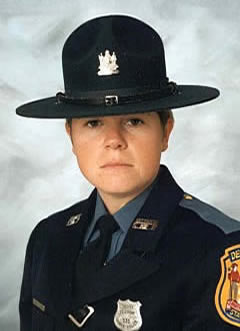
![]() On April 5th, 1996, Trooper Sandra M. Wagner,28, died from injuries sustained in an accident on State Route 404, west of Bridgeville. She had just completed the field training program the week before and had received her first assignment at Troop 5 Bridgeville. She was killed when she pulled her patrol vehicle into the path of a tractor-trailer, apparently intent on stopping a speeding motorist. Trooper Wagner was transported to Milford Memorial Hospital where she later died from injuries she sustained in the collision. She was laid to rest on April 10, 1996 at All Saints Cemetery in New Castle County. Trooper Wagner was the first female trooper to be killed in the line of duty.
On April 5th, 1996, Trooper Sandra M. Wagner,28, died from injuries sustained in an accident on State Route 404, west of Bridgeville. She had just completed the field training program the week before and had received her first assignment at Troop 5 Bridgeville. She was killed when she pulled her patrol vehicle into the path of a tractor-trailer, apparently intent on stopping a speeding motorist. Trooper Wagner was transported to Milford Memorial Hospital where she later died from injuries she sustained in the collision. She was laid to rest on April 10, 1996 at All Saints Cemetery in New Castle County. Trooper Wagner was the first female trooper to be killed in the line of duty.
In 1995, the DSTA completed construction of a hall in Cheswold, which is utilized for Association meetings and other social events.
In an attempt to provide our youth with a safe environment in which they can learn and develop, the Delaware State Police became involved in the  School Resource Officer (SRO) program in 1996. The SRO program places a plainclothes trooper within a particular school or school district as a resource to school administrators and students. The individual school district usually pays for the troopers salary, therefore it is a partnership agreement. The school district receives the benefit of having a trooper assigned to the district full time to handle any matters that may require an officer. The troopers also interact with students on a daily basis, opening the lines of communication and establishing trust. In addition to investigating all criminal offenses which occur on the school grounds, the School Resource Officers provide counseling services and referrals, and conduct presentations to students and school faculty relating to a variety of law enforcement issues.
School Resource Officer (SRO) program in 1996. The SRO program places a plainclothes trooper within a particular school or school district as a resource to school administrators and students. The individual school district usually pays for the troopers salary, therefore it is a partnership agreement. The school district receives the benefit of having a trooper assigned to the district full time to handle any matters that may require an officer. The troopers also interact with students on a daily basis, opening the lines of communication and establishing trust. In addition to investigating all criminal offenses which occur on the school grounds, the School Resource Officers provide counseling services and referrals, and conduct presentations to students and school faculty relating to a variety of law enforcement issues.
 In 1997, a new firearms facility is anticipated to be complete. The new building will house an indoor range, with a targeting system that allows for "shoot/ don't shoot" scenarios. The range will have twenty lanes and include a state of the art bullet recovery system. It will be located north of Smyrna in New Castle County. The current range, which is outdoors on Denny's Road, Dover, will be maintained as a training site for the Special Operations Response Team.
In 1997, a new firearms facility is anticipated to be complete. The new building will house an indoor range, with a targeting system that allows for "shoot/ don't shoot" scenarios. The range will have twenty lanes and include a state of the art bullet recovery system. It will be located north of Smyrna in New Castle County. The current range, which is outdoors on Denny's Road, Dover, will be maintained as a training site for the Special Operations Response Team.
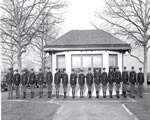 A new Troop 2 facility has been proposed in the area of Route's 40 and 896, in Glasgow, with a possible completion date of 1999. The current Troop 2 was built in 1939, and currently houses only criminal detectives. It is anticipated that the proposed new building will incorporate both uniform officers and detectives. The new building is in the very preliminary stages, with money allocated by the General Assembly for consultant fees to study the project.
A new Troop 2 facility has been proposed in the area of Route's 40 and 896, in Glasgow, with a possible completion date of 1999. The current Troop 2 was built in 1939, and currently houses only criminal detectives. It is anticipated that the proposed new building will incorporate both uniform officers and detectives. The new building is in the very preliminary stages, with money allocated by the General Assembly for consultant fees to study the project.
The Delaware State Police Community Services Section recently created a program entitled the "Seven-Up Club". The program  targets at risk eighth graders at the Henry B. duPont Middle School where 28 participants were selected from among the school's most troubled youth. In order to join the club, the youth must take a simple pledge, "Show pride and dignity in yourself". The troopers meet with the members and discuss different issues facing the children, such as drugs and school violence, then meet with each child’s parents at home in order to learn about their environment away from the school. The effort has resulted in improved grades and behavior among the program’s participants.
targets at risk eighth graders at the Henry B. duPont Middle School where 28 participants were selected from among the school's most troubled youth. In order to join the club, the youth must take a simple pledge, "Show pride and dignity in yourself". The troopers meet with the members and discuss different issues facing the children, such as drugs and school violence, then meet with each child’s parents at home in order to learn about their environment away from the school. The effort has resulted in improved grades and behavior among the program’s participants.
 During the 1995-1996 school year, the Delaware State Police implemented a new program known as GREAT, (Gang Resistance Education and Training). The program is designed to equip middle school students with the skills necessary to resist gang activity. One thousand two hundred seventh grade students from three schools in New Castle County received the training during the 1995-1996 school year.
During the 1995-1996 school year, the Delaware State Police implemented a new program known as GREAT, (Gang Resistance Education and Training). The program is designed to equip middle school students with the skills necessary to resist gang activity. One thousand two hundred seventh grade students from three schools in New Castle County received the training during the 1995-1996 school year.
The Business Community Crimes Unit was formed in the fall of 1995, with money from a federal grant. The unit's main purpose is to form a partnership between the business community and the Delaware State Police. The first site for the unit was the Fox Run shopping center in New Castle County. A trooper is assigned to educate the business community in the areas of crime prevention, personal safety and security. In the future, a county-wide business community watch program is to be developed, which will allow for the registering of all businesses served by the Delaware State Police.
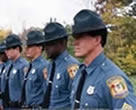
In 1995, the division created a uniformed unit to work with the undercover officers of the drug unit. The Special Investigations Tactical Unit consists of five officers who work in uniform with marked vehicles in areas which are known for drug activity. The unit arrests known drug dealers and acts on intelligence gathered from the undercover drug officers.
In an effort to fight drug dealers that ride dirt-bikes in the Williamsville area, troopers from Troop 3 have coordinated an effort to repair poor roadways. The unpaved entrance to the area was of poor quality and full of pot holes and ruts, making police access difficult. Drug dealers would simply flee on dirt-bikes to avoid capture. With the assistance of inmates from the Morris Correctional Center, the road was repaired, making police interdiction efforts easier.
Sixty-five percent of homicides investigated by the Delaware State Police are reported to be domestic related. Of these domestic complaints reported to 911 centers in Delaware, 44% are calls to residences  where the Delaware State Police have previously responded. In October 1996, funding was received through a federal grant to create a Domestic Violence Unit. The unit is modeled after a similar one in San Diego, California, which saw a drop in recidivism of repeat offenders from 50% to 3%, as well as a 50% decrease in the domestic homicide rate. The grant allows for seven troopers to staff the unit, with three in Sussex County, two each in Kent and New Castle Counties. The unit will work closely with Family Court, serve as a liaison with the Attorney General's office, work with hospitals, and coordinate efforts with the Victim Services Unit. The unit will also monitor Protection From Abuse orders issued by Family Court and track repeat offenders.
where the Delaware State Police have previously responded. In October 1996, funding was received through a federal grant to create a Domestic Violence Unit. The unit is modeled after a similar one in San Diego, California, which saw a drop in recidivism of repeat offenders from 50% to 3%, as well as a 50% decrease in the domestic homicide rate. The grant allows for seven troopers to staff the unit, with three in Sussex County, two each in Kent and New Castle Counties. The unit will work closely with Family Court, serve as a liaison with the Attorney General's office, work with hospitals, and coordinate efforts with the Victim Services Unit. The unit will also monitor Protection From Abuse orders issued by Family Court and track repeat offenders.
The division continues to ensure that all of its members receive the latest available training and continue to receive education in their particular fields of specialization. The Delaware State Police created a leadership development course curriculum to be given to sergeants and lieutenants in 1996. The goal of the training was to provide leadership training for first and second line supervisors. The courses last one to two weeks, with emphasis on management theory and human relations skills.
A new initiative which began in 1996 is known as "roll call" training. Short five to ten minute blocks of instruction including both written and video material are conducted during roll call before a shift goes on patrol. Examples of topics include the divisional pursuit and force policies, sexual harassment, etc. The concept behind the training is to give the information in short blocks at the troop level, instead of taking a trooper off the street for longer periods of time.
 In order to assist drill instructors with some of the responsibilities which they incur when recruit classes are being trained, a program was initiated in 1996 called "TAC", Trainer Adviser Counselor. The program allows for troopers to rotate from other assignments in the field to the academy to assist with the training of the recruits. The troopers receive specialized training before they are assigned as "TAC's". Their stay at the academy usually lasts for approximately seven weeks, divided into two to three week periods.
In order to assist drill instructors with some of the responsibilities which they incur when recruit classes are being trained, a program was initiated in 1996 called "TAC", Trainer Adviser Counselor. The program allows for troopers to rotate from other assignments in the field to the academy to assist with the training of the recruits. The troopers receive specialized training before they are assigned as "TAC's". Their stay at the academy usually lasts for approximately seven weeks, divided into two to three week periods.
 Technology has been on the forefront of advances in policing during the decade. Officers in the field have access to immediate information via computer terminals mounted in their patrol cars, allowing them to work with greater efficiency. Accident investigators now have the ability to measure the most complex collision scenes with speed and accuracy which was previously inconceivable. Advances in the area of fingerprint analysis and drug detection have facilitated the detection of crimes which may have previously gone unsolved. New laser technology is used to detect speeders and traffic violators, in an effort to reduce injuries and deaths related to traffic accidents.
Technology has been on the forefront of advances in policing during the decade. Officers in the field have access to immediate information via computer terminals mounted in their patrol cars, allowing them to work with greater efficiency. Accident investigators now have the ability to measure the most complex collision scenes with speed and accuracy which was previously inconceivable. Advances in the area of fingerprint analysis and drug detection have facilitated the detection of crimes which may have previously gone unsolved. New laser technology is used to detect speeders and traffic violators, in an effort to reduce injuries and deaths related to traffic accidents.
The Delaware State Police went "on-line" in 1996 with the creation of an Internet site on the world wide web. The address is as follows: http://www.state.de.us/dsp
Information on the site includes:
- The Executive Staff
- Table of Organization
- Information on the Various Troops and Sections
- A History of the Division
- Delaware's Most Wanted
The year 1995 witnessed the development and testing of the Mobile Data Terminal project (MDT). This was a program in which lap-top computers were placed in patrol vehicles to allow troopers immediate access to information. Through the MDT, a trooper can run data requests from the vehicle, such as drivers license or registration information. This saves the officer from making the request through the communication centers, which are often busy with requests from many different officers 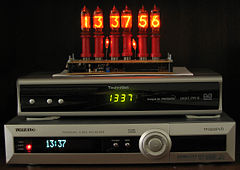 simultaneously. The clear advantage is time-savings for the patrol trooper waiting for information. The Delaware State Police is the first law enforcement agency in the state to use this technology. In addition to data requests, a patrol trooper can also complete a criminal warrant and fax a copy to the magistrate court. The warrant can then be reviewed by the judge before the trooper's arrival at court, and then signed when the warrant is sworn to, providing additional time savings. The trooper can also complete crime and accident reports on the MDT, allowing them to remain on patrol while they complete paperwork. At the end of the shift, the trooper can return to the troop and simply print out their reports for the day. The program was tested as follows: five terminals at Troop 1, one terminal at Troop 3, and one terminal at Troop 7. The pilot project was a success, resulting in the acquisition of 44 terminals through a federal grant in February, 1997. Funding for additional MDT’s will be sought on a continuing basis with the hope that all patrol cars will eventually be equipped with the terminals.
simultaneously. The clear advantage is time-savings for the patrol trooper waiting for information. The Delaware State Police is the first law enforcement agency in the state to use this technology. In addition to data requests, a patrol trooper can also complete a criminal warrant and fax a copy to the magistrate court. The warrant can then be reviewed by the judge before the trooper's arrival at court, and then signed when the warrant is sworn to, providing additional time savings. The trooper can also complete crime and accident reports on the MDT, allowing them to remain on patrol while they complete paperwork. At the end of the shift, the trooper can return to the troop and simply print out their reports for the day. The program was tested as follows: five terminals at Troop 1, one terminal at Troop 3, and one terminal at Troop 7. The pilot project was a success, resulting in the acquisition of 44 terminals through a federal grant in February, 1997. Funding for additional MDT’s will be sought on a continuing basis with the hope that all patrol cars will eventually be equipped with the terminals.
 The implementation of the 800 MegaHertz, (MHz), radio system began in 1996, and continues into 1997. The project will replace the two way radio system used since the 1970’s. The 800 MHz system will allow troopers at opposite ends of the state to talk to one another as though it were a phone call. The project utilizes a "trunked system", which is similar to that of cellular phones. Users will include other state agencies in addition to the Delaware State Police. The 800 MHz system is being brought on line in phases, to ensure officer safety and allow for familiarization with the new radios. New Castle County will be the first on line, with Kent and Sussex Counties, respectively, following approximately 12-18 months apart. The existing radio system will be maintained simultaneously, until the 800 MHz is completely functional statewide.
The implementation of the 800 MegaHertz, (MHz), radio system began in 1996, and continues into 1997. The project will replace the two way radio system used since the 1970’s. The 800 MHz system will allow troopers at opposite ends of the state to talk to one another as though it were a phone call. The project utilizes a "trunked system", which is similar to that of cellular phones. Users will include other state agencies in addition to the Delaware State Police. The 800 MHz system is being brought on line in phases, to ensure officer safety and allow for familiarization with the new radios. New Castle County will be the first on line, with Kent and Sussex Counties, respectively, following approximately 12-18 months apart. The existing radio system will be maintained simultaneously, until the 800 MHz is completely functional statewide.
Another technological advancement which should prove invaluable in the cataloguing of fingerprint data is referred to as "Livescan". In appearance, the machine resembles an automatic teller machine, commonly used at banks. The livescan allows for the inkless fingerprinting of subjects. A persons finger  is rolled across a glass screen, which has a light underneath similar to a copy machine. As the light moves, the trooper rolls the subject’s finger across the screen. The machine actually takes a picture of the prints, and then reproduces them onto a print card. If the person already has information in the criminal justice system, that information will either be printed onto the card or added at the terminal. If a subject has no identification, or gives a false name to the trooper, their prints can be compared at the State Bureau of Identification from the livescan instantly. The "inkless" printing and quick comparison save both time and effort involved in processing subjects. The instant comparison feature will also help prevent the release of possible dangerous subjects who give the police false identification at the time of arrest. Each state police troop will be equipped with livescan.
is rolled across a glass screen, which has a light underneath similar to a copy machine. As the light moves, the trooper rolls the subject’s finger across the screen. The machine actually takes a picture of the prints, and then reproduces them onto a print card. If the person already has information in the criminal justice system, that information will either be printed onto the card or added at the terminal. If a subject has no identification, or gives a false name to the trooper, their prints can be compared at the State Bureau of Identification from the livescan instantly. The "inkless" printing and quick comparison save both time and effort involved in processing subjects. The instant comparison feature will also help prevent the release of possible dangerous subjects who give the police false identification at the time of arrest. Each state police troop will be equipped with livescan.
In 1997, the Delaware State Police is considering the use of Lo-Jack, which is a stolen vehicle recovery project. Under  the program, a device is placed in an undisclosed location on a vehicle. If the vehicle is stolen, the device can be activated remotely by the police. The vehicle will then emit an electronic signal, which can be received by devices placed in patrol vehicles. While on patrol, the trooper can locate stolen vehicles by using the equipment. While the project is in the preliminary stages, many states along the east coast are currently using the system. The costs will be minimal, as the vehicle owner is responsible for paying for the unit to be placed in their vehicle.
the program, a device is placed in an undisclosed location on a vehicle. If the vehicle is stolen, the device can be activated remotely by the police. The vehicle will then emit an electronic signal, which can be received by devices placed in patrol vehicles. While on patrol, the trooper can locate stolen vehicles by using the equipment. While the project is in the preliminary stages, many states along the east coast are currently using the system. The costs will be minimal, as the vehicle owner is responsible for paying for the unit to be placed in their vehicle.
With the training of the 66th recruit class, hired in January, 1997, the strength of the Delaware State Police will total 566 sworn members. This class of troopers will face a society marked by rapid technological and societal change, where the only thing constant is change itself. The trend of increased public demand for police services will continue into the next century. Technological advances will also continue to assist and change the way policing itself is done.
The year 1998 is truly a milestone for the Delaware State 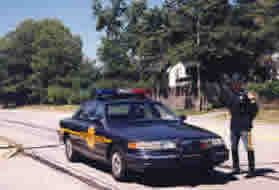 Police. This is the year we celebrate 75 years of existence, and take time to reflect on the accomplishments of our past. The year also places us on the threshold of a new millennium, and all of the excitement and challenges the division will face in the years to come. If past history is an indicator, we will undoubtedly experience many changes and continue to evolve in order to meet the needs of the citizens we police. Throughout these changes we must strive to continue to exhibit the unwavering dedication and courage which troopers of the past have displayed in the performance of their duties and exhibit the tradition of quality service to the public which has been our trademark for the last 75 years. In the following year, the Division developed another unit called the Governor’s Task Force or GTF that paired probation officers with Troopers to address quality of life issues in high crime areas. Lastly, the indoor firing range facility was constructed near Smyrna which proved to be a valuable asset for the training needs of Troopers and other agencies.
Police. This is the year we celebrate 75 years of existence, and take time to reflect on the accomplishments of our past. The year also places us on the threshold of a new millennium, and all of the excitement and challenges the division will face in the years to come. If past history is an indicator, we will undoubtedly experience many changes and continue to evolve in order to meet the needs of the citizens we police. Throughout these changes we must strive to continue to exhibit the unwavering dedication and courage which troopers of the past have displayed in the performance of their duties and exhibit the tradition of quality service to the public which has been our trademark for the last 75 years. In the following year, the Division developed another unit called the Governor’s Task Force or GTF that paired probation officers with Troopers to address quality of life issues in high crime areas. Lastly, the indoor firing range facility was constructed near Smyrna which proved to be a valuable asset for the training needs of Troopers and other agencies.

